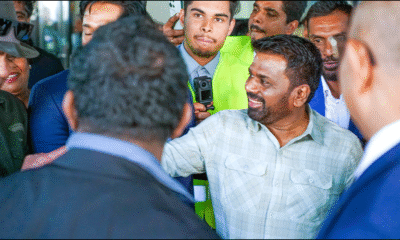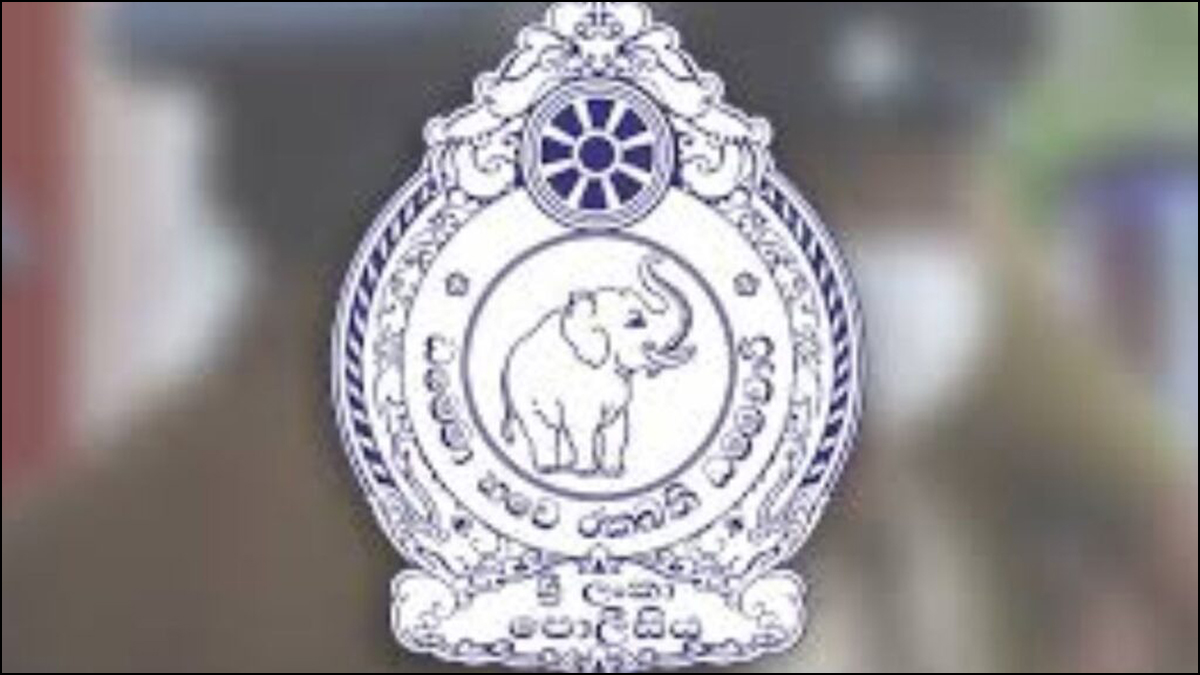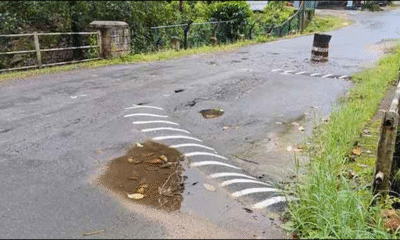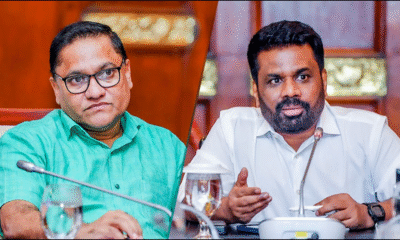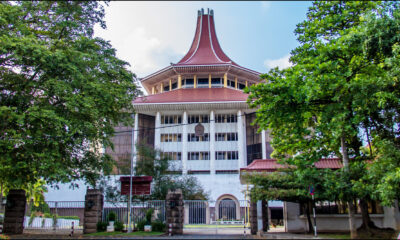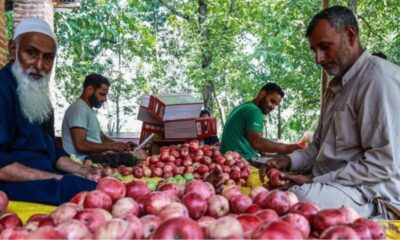FEATURES
Threat to Kashmir’s iconic chinar trees – and the fight to save them
Published
4 months agoon
By
editor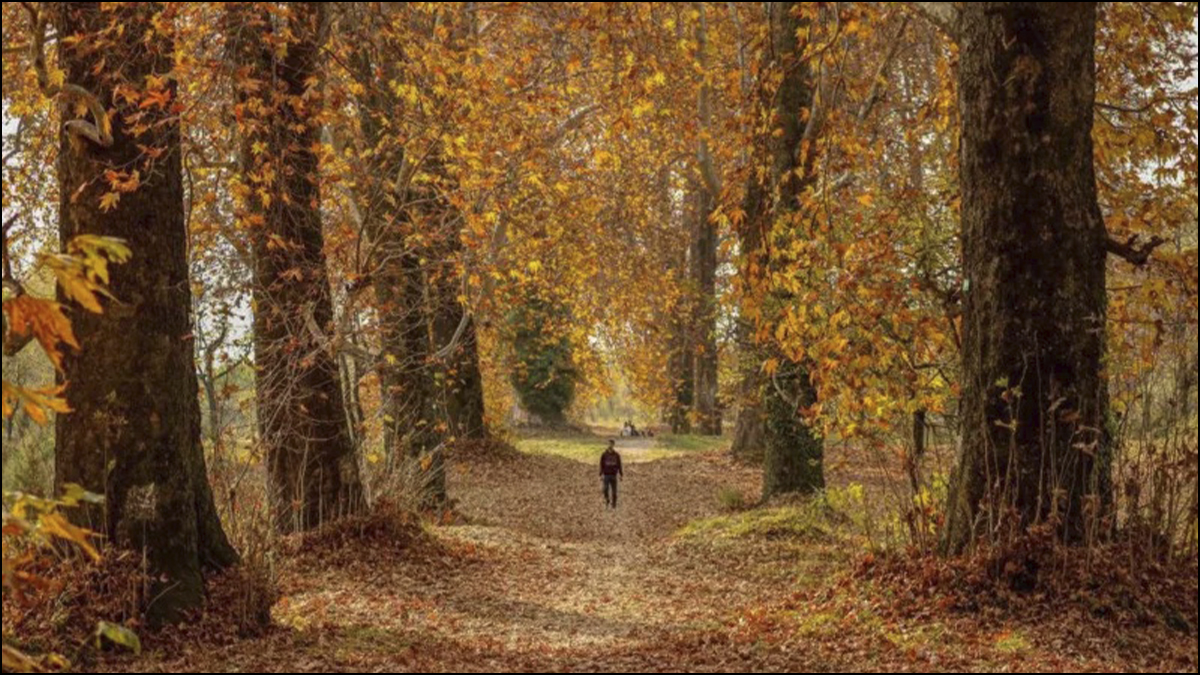
Was it pruning or felling?
The alleged chopping of centuries-old chinar trees in Indian-administered Kashmir has sparked outrage, with locals and photos suggesting they were cut down, while the government insists it was just routine pruning. The debate has renewed focus on the endangered tree and efforts to preserve it.
The chinar is an iconic symbol of the Kashmir valley’s landscape and a major tourist draw, especially in autumn when the trees’ leaves light up in fiery hues of flaming red to a warm auburn.
The trees are native to Central Asia but were introduced to Kashmir centuries ago by Mughal emperors and princely kings. Over the years, they have come to occupy an important place in Kashmiri culture.
But rapid urbanisation, illegal logging and climate change are threatening their survival, prompting authorities to take steps to conserve them.
The Jammu and Kashmir government has been geotagging chinar trees in an effort to keep track of them and their health. The project involves attaching a QR code to each tree with information about its location, age and other physical characteristics.
“We are ‘digitally protecting’ chinar trees,” says Syed Tariq, a scientist who’s heading the project. He explains that information provided by the QR code can help locals and tourists get to known more about a tree, but it can also help counter problems like illegal or hasty cutting of them.
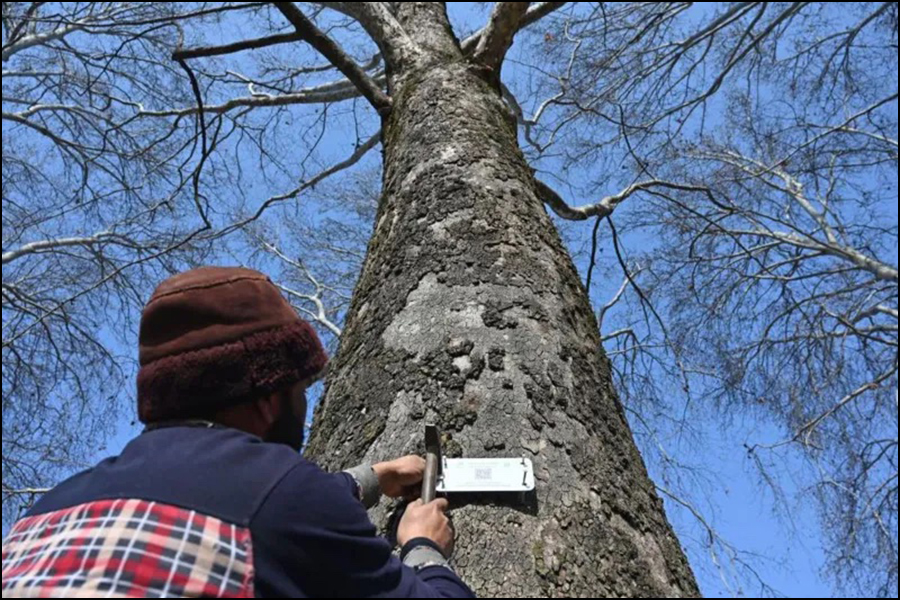
The project has geotagged about 29,000 chinar trees so far, with another 6,000–7,000 still left to be mapped.
Despite its heritage value, there was no proper count of these trees, says Mr Syed. While government records cite 40,000, he calls the figure debatable but is certain their numbers have declined.
This is a problem because the tree takes at least 50 years to reach maturity. Environmentalists say new plantations are facing challenges like diminishing space. Additionally, chinar trees need a cool climate to survive, but the region has been experiencing warmer summers and snowless winters of late.
But on the bright side, these trees can live for hundreds of years – the oldest chinar tree in the region is believed to be around 700 years old. A majority of the trees are at least a few centuries old and have massive trunks and sprawling canopies.
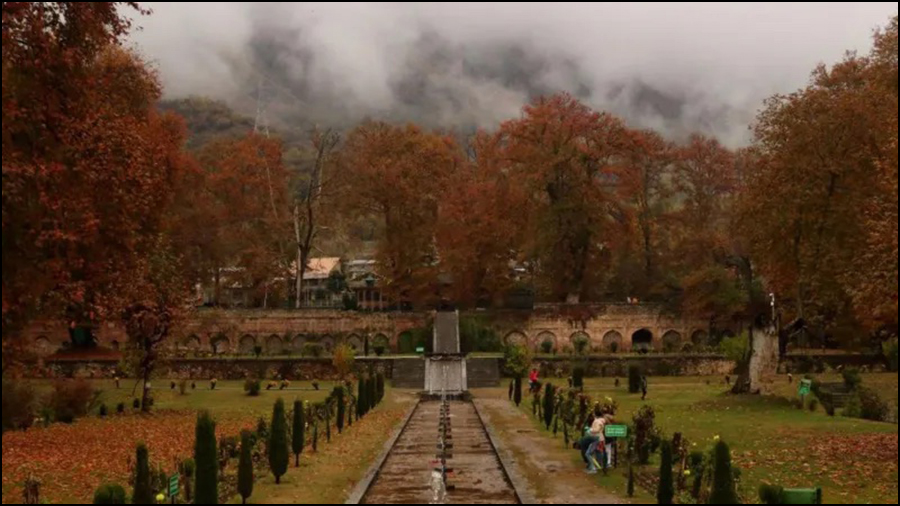
The trees received maximum patronage during the Mughal period, which stretched from the early 1500s to the mid-1800s. Many of the trees that exist in the valley were planted during this period, Mr Syed says.
The Mughal kings, who ruled many parts of erstwhile India, made Kashmir their summer getaway due to its cool climate and beautiful scenery. They also erected “pleasure gardens” – landscaped gardens famous for their symmetry and greenery – for their entertainment.
The chinar enjoyed pride of place in these gardens and the trees were usually planted along water channels to enhance the beauty of the place. Many of these gardens exist even today.
According to government literature, in the 16th Century Mughal emperor Akbar planted around 1,100 trees in one such pleasure garden near the famous Dal Lake in Srinagar, but about 400 have perished over the years due to road-widening projects and diseases caused by pests.
Emperor Jahangir, Akbar’s son, is said to have planted four chinar trees on a tiny island in Dal Lake, giving it the name Char Chinar (Four Chinars) – now a major tourist draw. Over time, two trees were lost to age and disease, until the government replaced them with transplanted mature trees in 2022.
Interestingly, the chinar is protected under the Jammu and Kashmir Preservation of Specified Trees Act, 1969, which regulates its felling and export and requires official approval even for pruning. The law remains in force despite the region losing statehood in 2019.
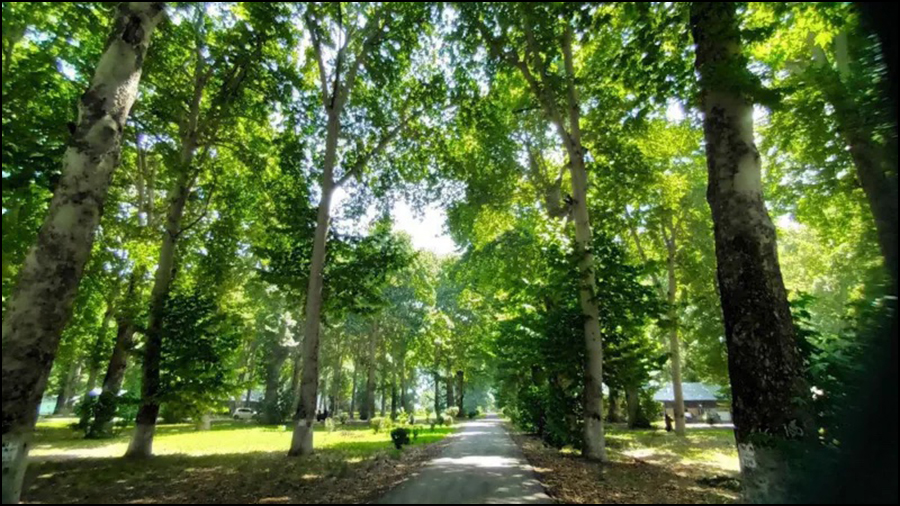
But environmental activist Raja Muzaffar Bhat says authorities often exploit legal loopholes to cut down chinar trees.
“Under the garb of pruning, entire trees are felled,” he says, citing a recent alleged felling in Anantnag district that sparked outrage.
“The government is geotagging trees on one side, but cutting them on the other,” he says. He adds that while authorities remove trees for urban projects, locals also fell them illegally.
Chinar trees have durable hardwood, ideal for carvings, furniture and artefacts. Locals also use them for firewood and making herbal medicine.
Government projects like geotagging are raising awareness, says Mr Bhat. He adds that Kashmiris, deeply attached to the chinar as part of their heritage, now speak out against its felling or damage.
Last week, many posted photos of the allegedly chopped trees in Anantnag on X (formerly Twitter) while opposition leaders demanded that the government launch an investigation and take action against the culprits.
“The government should protect the trees in letter and in spirit,” Mr Bhat says.
“Because without chinar, Kashmir won’t feel like home.”
– Cherylann Mollan
BBC News, Mumbai
You may like
FEATURES
What’s “National Security” for Sri Lanka?
Published
11 hours agoon
June 14, 2025By
editor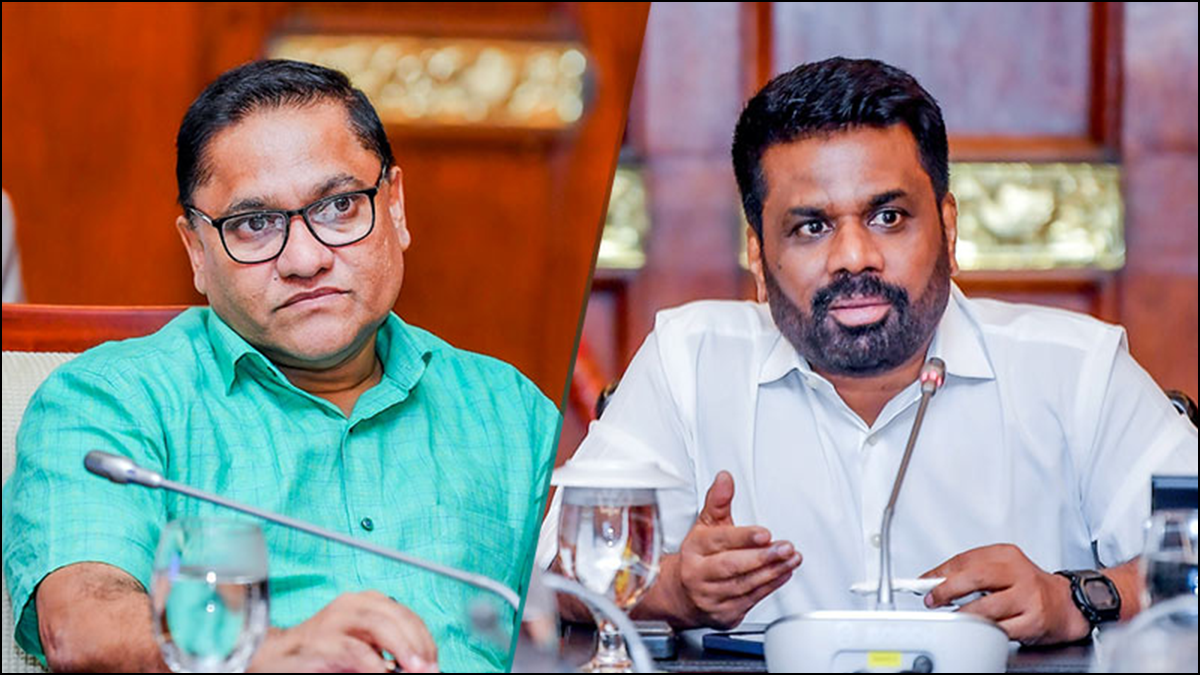
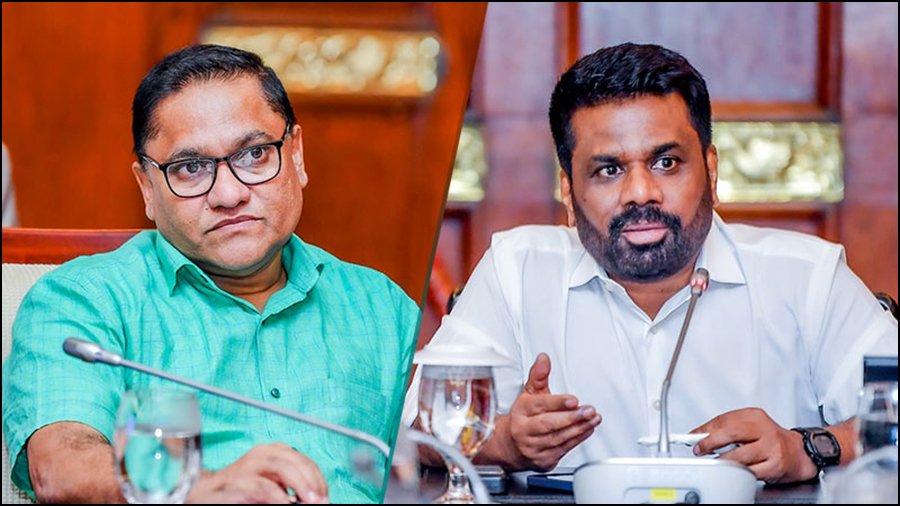
Remember listening to a young lady TV Anchor in a private TV channel a few months ago, demanding from an Opposition MP, what threats he is referring to as “threats to national security”. On her own definition, she was quite certain there are “no threats to national security” as claimed by the Opposition. “Its past midnight when I go home…. after these programmes” she said on camera. “I have never felt any threat to me” she added. The opposition argument was, heavy increase in “shootings” during the past few months in most parts of the country and an increase in deaths due to such shootings, would bring about a threat to “National Security” if not controlled immediately.
But what is “National Security?”
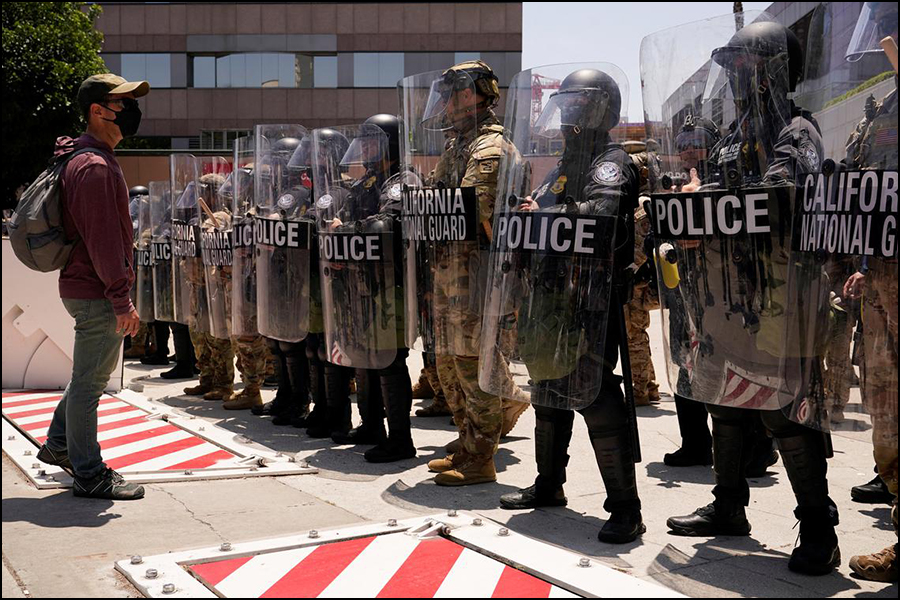
The concept of “national security” evolved over many decades ago with assumed “external threats” to a nation and its people. During the past two plus decades, especially after the New York 9/11 terrorist attack, the concept of national security has been broadened beyond “nations” with intensive intelligence gathering networks. Ethnic and religious conflicts, border clashes and environmental degradation have been added since. The most recent Indo-Pak armed conflict, is one that is spoken of as a “national threat” to India among “Shiv Sena and Hindutva” groups.
We in Sri Lanka, did have remotely manipulated threats to our national security, first in early 1980’s when Indira Gandhi was Prime Minister in neighbouring India. Her perception of Jayawardene presidency as heavily weighted towards US, was what compelled her to intervene in our politics. In his book “Assignment Colombo” the Indian High Commissioner in Colombo J.N. Dixit wrote, “The first step that Mrs. Gandhi took was to give support to Sri Lankan Tamil parties and Tamil militant groups from 1980 onwards, details of which have been mentioned in a number of articles and books over the last 09 years. There is no need for me to repeat them”. (p/15)
As said, details given in many other writings confirm PM Indira Gandhi provided Sri Lankan armed Tamil groups with funds, military training and arms. In 1997, visiting Dehradun that borders Himalayas, I had a wholly unexpected meeting with a social activist very close to the Gandhi family. He took me to the “Rashtriya Indian Military College” in Garhi Cantt, where a select group of LTTE cadres had been trained to use “RPGs” and mortars. I was shown a massive rock in the hills, not too far away from the military college and told, mortars were fired at that rock during training.
Then Tamil Nadu (TN) Chief Minister, Sri Lankan born M.G. Ramachandran, popularly known in Tamil cinema as MGR, provided special accommodation to most Tamil armed group leaders and is said to have funded the LTTE nurturing a special fancy towards Prabhakaran. All that certainly was collective Indian manipulations in undermining our national security.
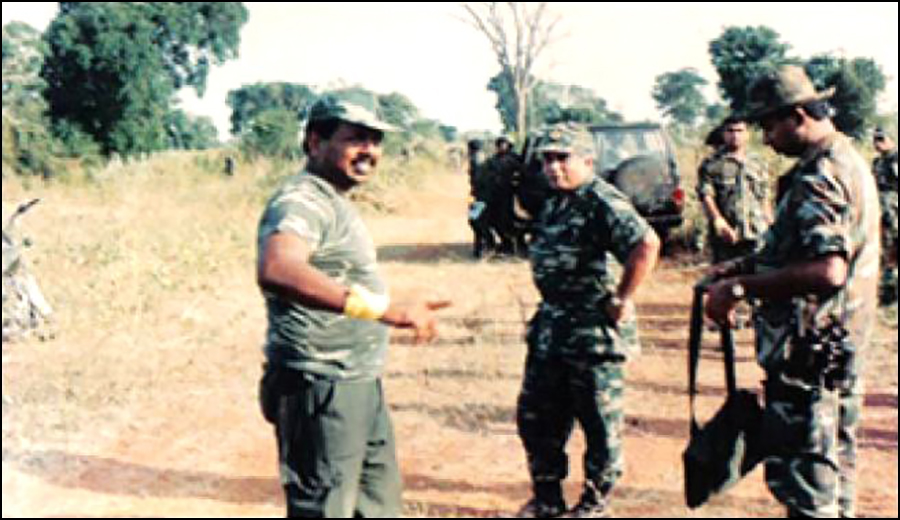
The next came in 1987 June. Then State Minister of Defence Lalith Athulathmudali a hardliner in Indo-Sri Lanka relations, endorsed a military offensive in March 1987 to take over Jaffna peninsula. Towards end May, the state military entered Jaffna peninsula and was pushing the LTTE towards Wadamarachchi. New Delhi hastened to inform the Colombo government, they want the “Wadamarachchi offensive” stopped immediately, to avoid a situation of mass hunger in the peninsula. Food not used as a “weapon of war”, Athulathmudali was determined to take-over whole of Jaffna peninsula in less than 02 weeks and was in no mood to halt the military offensive.
Yet Tamil Nadu convinced PM Rajiv Gandhi to decide on a flotilla of naval boats to deliver food to Jaffna. When Sri Lankan navy stopped them from entering SL waters and forced them to return to Rameswaran on June 03, India had decided on the ill-famed “air drop” on Jaffna, violating Sri Lankan airspace. On 04 June the airdrop of food parcels was carried out with SL High Commissioner in New Delhi Bernard Thilakaratne informed of the air drop about an hour before. Next day the Indian media carried the news of Indian Air force “successfully” completing “Operation Poomalai” by dropping food parcels on Jaffna that brought the Wadamarachchi offensive to a stop.
The last such threat on Sri Lankan national security was when PM Rajiv Gandhi in July 1987 almost coerced President Jayawardene to accept his government’s answer to the Sri Lankan Tamil armed conflict. The Indo-Sri Lanka Accord was signed in Colombo in July 1987 that led to Indian Peace Keeping Forces (IPKF) taking over security of North-East and formation of elected Provincial Councils with devolved power. In Sinhala South, opposing the PCs and the IPKF presence, the JVP unleashed a terror campaign leading to complete mayhem.
All that being history, since President Rajapaksa declared the war as “victoriously concluded” on 19 May, 2009 with the LTTE and its entire leadership eliminated, Modi’s India has become a strong ally of Sri Lanka in its efforts to tide over the recent economic crisis. There remained no other external factor that can be assumed as an imminent threat to Sri Lanka’s national security.
What then is the Opposition assuming as a possible threat to our national security with increased shootings and deaths during the past few months? Unless these underworld groups are bought over by an “external agency” in the future, for now, they are only a threat to social stability and peace, and not “national security”. They act on their own agenda, nevertheless creating an uncertainty about citizen’s safety and security to life. It is therefore about how efficient the government is, in policing society, ensuring law and order for all and one.
NPP Foreign Policy & Genocide
If at all, what could in the future be a threat to our national security is the present NPP government’s pro-US foreign policy that accommodates Israel as a “peaceful” non-aggressive State, ignoring the genocidal war against Palestine. But on the ground, with mass recruitments of Israeli youth for the ongoing military offensives against Palestine since October 2023, Israeli government needs labour for their community based farming and for quick reconstruction of damaged buildings due to Hamas rocket fire.
Since Gotabhaya Rajapaksa as Secretary to the Ministry of Defence opened up links for Sri Lankan migrant employment in Israel, 02 MoUs signed between the two governments have in 2020 provided jobs for home stay female caregivers and again in 2023 for agriculture labour, subsequently extended for construction work as well. This year during the first 03 months, nearly 2,000 Sri Lankans have left to Israel as construction workers. In mid May this year, another 447 Sri Lankans were ready to leave according to Sri Lanka Bureau of Foreign Employment (SLBFE). (https://www.slbfe.lk/slbfe-news/447-sri-lankans-to-begin-employment-in-israels-construction-sector/)
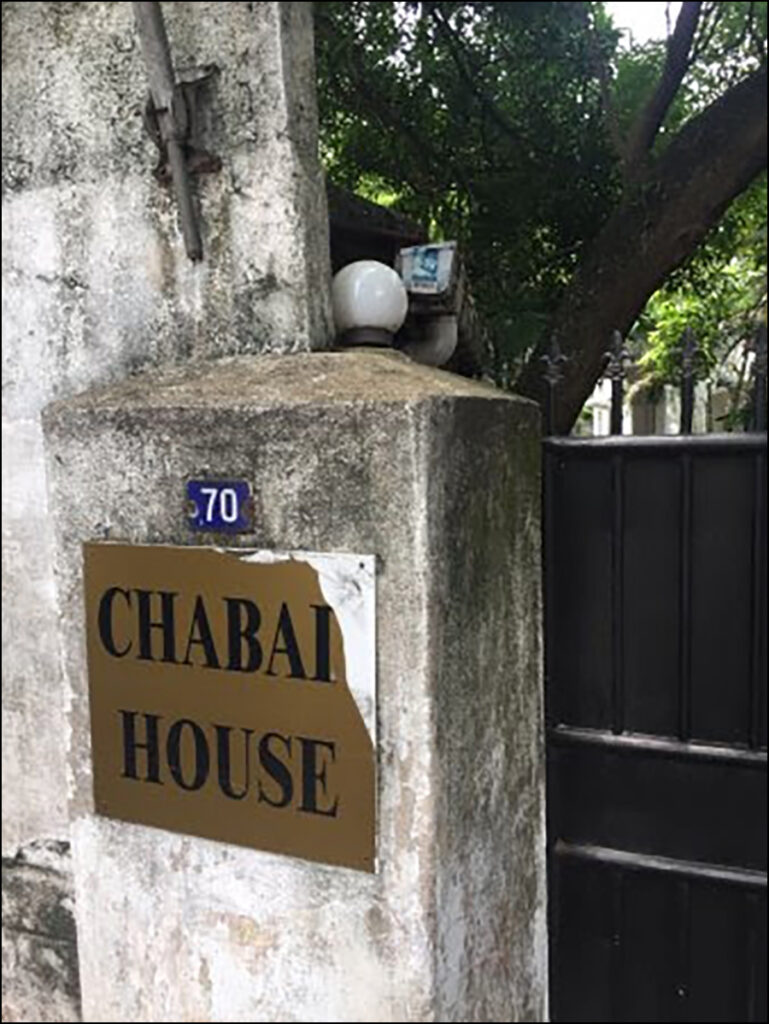
Added is the space provided by this NPP government for Israeli “tourists” to basically live here in Sri Lanka, with their own abodes and establishing cultural centres called “Chabad Houses”. It is rather puzzling how the NPP government could allow Israeli “tourists” to establish their cultural centres the government too accept as illegal, while providing armed police security for their safety. Presumably after a protest on the opposite pavement in front of the Chabad House in Kollupitiya on 09 May, a hurried announcement made by the Police Media Division on 11 May (2025) says, Israelis staying in Sri Lanka who have established Chabad Houses in some police divisions for their convenience, have been provided adequate security by those police divisions, due to threats to Chabad Houses. The police media division also says, if any foreign nationals staying in Sri Lanka needs security, SL Police would provide adequate security after an assessment on threats.
This NPP government’s foreign policy that officially provides SL labour for warring Israel and allows Israelis to “stay” in Sri Laka with State security, may in the future open Sri Lanka for “external” anti-Israeli threats as was discussed in many social forums over alleged ISIS links during the 2019 April Easter Sunday attacks that left 253 fatalities.
This possibility of destabilising Sri Lanka by external anti-Israeli agents, can only be counted by a principled change in foreign policy of the NPP government. With strong US support to stay within the IMF programme and with no alternate thinking, this government’s foreign policy can only be positively changed by rational social interventions by the Opposition that to date is totally absent. Sadly in Colombo, even the generally accepted educated, professional middleclass perception is wholly flawed. They claim they oppose genocide and stand in solidarity with Palestine, but have no demands for this NPP government to honour at least a viable ceasefire. No demand the NPP government should stop providing SL labour to Israel, heavily engaged in a brutal a war that to date has left over 55,000 Palestinians killed counting around 70 percent children and women, 180 journalists and over 224 humanitarian aid workers including 179 that worked for UN Relief and Works Agency (UNRWA).
If dollar remittances are all what matters to the NPP government, this NPP foreign policy of accommodating Israel, whose PM Benjamin Netanyahu and his former Defence Minister Yoav Gallant have arrest warrants issued by the International Criminal Court (ICC) for war crimes and crimes against humanity in Gaza, may invite threats to our national security, neither the NPP government nor the Opposition is willing to pay attention to.
– Kusal Perera
FEATURES
Indian scientists search for the perfect apple
Published
1 day agoon
June 13, 2025By
editor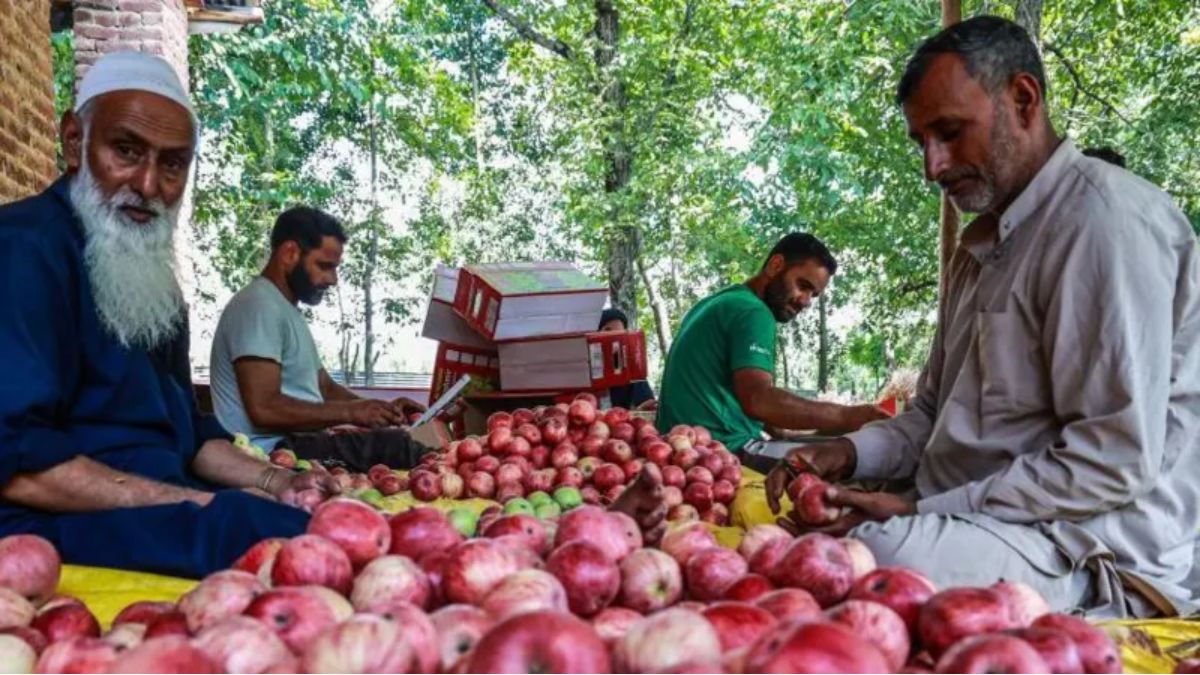
Jammu and Kashmir is India’s biggest apple producing region
“My neighbours thought I’d lost my mind,” says farmer Kakasaheb Sawant.
In 2022 he had decided to plant some apple trees, not crazy for a farmer unless, like Mr Sawant, you live in subtropical southern India, where temperatures can hit 43C.
He bought 100 saplings, of which 80 survived. Last year each tree produced between 30 and 40 kilogrammes of fruit.
“My farm has become something of a local miracle. People travel from far-off places just to see the apple trees growing under the hot Maharashtra sun.”
It’s not been an unqualified success though. One problem is that the apples are not sweet enough to sell.
Mr Sawant remains enthusiastic. He’s had some success selling apple tree saplings and is optimistic about future harvests.
“This is the beginning. The trees are getting acclimatised so according to me in next four to five years these trees will start bearing good, sweet apples.”
In his own small way, Mr Sawant is hoping to meet India’s rising demand for apples.
Production has risen 15% over the last five years to 2.5 million tonnes.
But that is not keeping up with demand and India’s imports have roughly doubled to 600,000 tonnes over the same period, according to S Chandrashekhar, who analyses India’s apple trade.
“We do have a shortage of apple production,” he says. “There are not many new players… at the same time, and there is no new investment.”
Essential for a good apple crop is a lengthy period of winter temperature between 0C and 6C.
Countries like the UK, with around 1,000 hours of this chill-time, can produce almost any apple variety.
But in India areas with those conditions are more limited.
Most of India’s apples come from two regions in the north of the country -Jammu and Kashmir and neighbouring Himachal Pradesh.
Mr Chandrashekhar says that many farms in those regions are becoming less productive.
“There are lot of old orchards producing fewer apples – that means the yield is coming down,” he says.
He says that climate change is making conditions less favourable.

Researches have grown apples in subtropical Ranchi, eastern India
In the hope of expanding apple production into new areas, some scientists and farmers are experimenting with so-called low-chill varieties.
Those are apple trees that can produce crops with around 400 hours of temperatures between 0C and 6C.
Ranchi, eastern India is also not an apple growing region – its subtropical climate is too hot.
But researchers at the Birsa Agricultural University (BAU) are testing 18 saplings of three low-chill varieties.
Success has been limited so far – only one of the varieties has produced any fruit.
“The plants have not reached optimal sizes. The tree has given us only around one to two kilogrammes of apples in 2024. I would not say that they are of best quality, but they were edible,” says Dr Majid Ali.
He says that as well as an unfavourable climate, the local soil is not ideal for apple trees and the trees get attacked by termites.
“This is an experimental stage. To reach a conclusion it would take three to four years to say if it is successful.”
He says that some local farmers have also been experimenting with low-chill apple varieties, also with little success.

India’s apple growers are struggling to keep up with demand
Some are sceptical that apples cultivated in hot areas will ever be a commercial proposition.
“The fruit that grows in non-traditional regions has a very short shelf life. The taste is not so sweet,” says Dr Dinesh Thakur, associate director of a regional horticulture research and training centre at Dr YS Parmar University of Horticulture and Forestry.
“These low-chill apples can be grown as novelty fruit in a kitchen garden, but their viability as a commercial crop is not proven… most of them are a failure,” he says.
Dr Thakur is based in the traditional northern apple growing region of Himachal Pradesh and his research focuses on the improvement of apples through breeding.
“Climatic change is creating havoc in apple cultivation,” he says.
He says the number of those crucial chilling hours are falling and due to erratic weather conditions farmers are facing colossal financial losses every year.
In search of better conditions, some orchards are being planted in higher locations, which were once considered too cold, he says.
Under a government sponsored project his team are experimenting with 300 varieties of apples, to assess the impact of climate change.
“We are also working on climate-resilient apple genotypes that can withstand the existing climate,” he says.
So far, they have developed an apple that matures with a ripe colour two months earlier than existing apple trees.
“This helps offset erratic weather patterns brought by climate change and has a quality advantage over those areas where colour formation is problem due to lack of sunlight,” Dr Thakur says.
“This is just the beginning of research to create climate resilient fruit and create a fruit that is acceptable to the Indian taste bud.”
For Mr Chandrashekhar, boosting India’s apple output will take more than just scientific work.
“Apple orchards in the traditional apple cultivation areas are 15 to 20 years old. What is needed is replanting of new saplings,” he says.
“The industry needs investment, huge investment. Who will do that?” he asks.
He would like to see the juice and jam business developed, to provide the industry with another source of income.
“That has to be a booster which can improve the apple economy and provide a better position for apple growers.”
– Priti Gupta
(BBC News)
FEATURES
NONE worried about massacre of the UN “Founding Charter”
Published
2 weeks agoon
June 2, 2025By
editor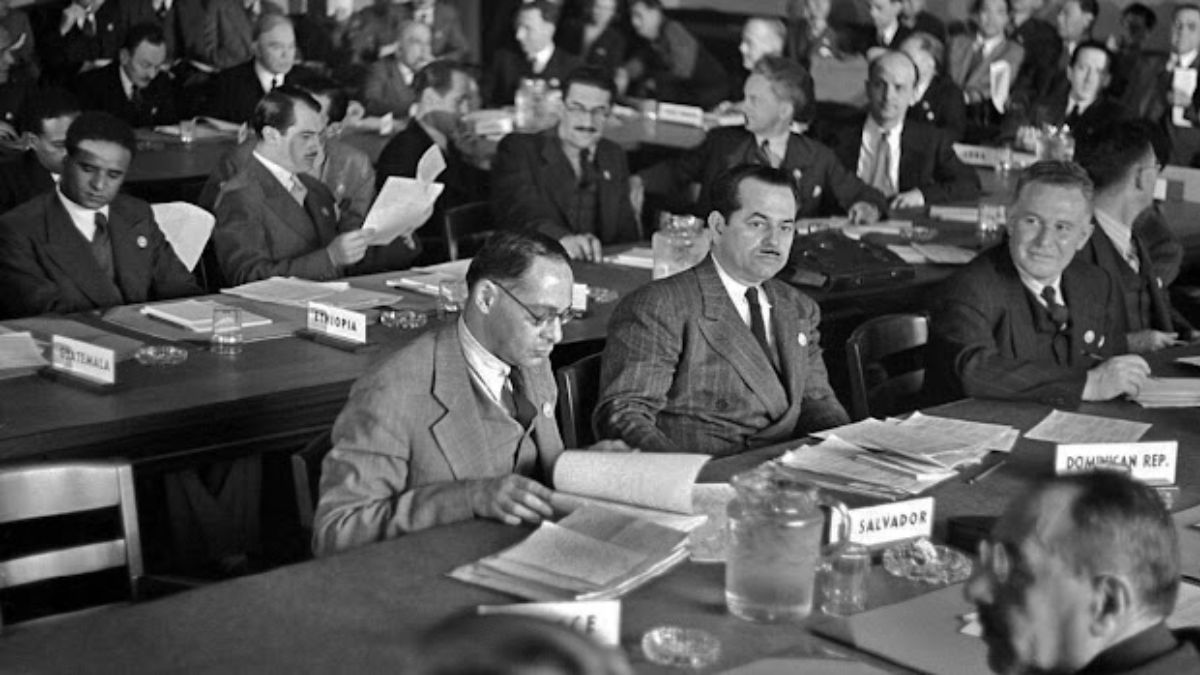
UN Founding Conference 1945 April 25 to June 26 – Courtesy UN Photos
Here is the opening pledge of the UN Charter on which the United Nations was officially declared established in October 1945 after WW II was brought to an end.
“We the People’s of the United Nations determined to save succeeding generations from the scourge of war, which twice in our lifetime has brought untold sorrow to mankind, and
to reaffirm faith in fundamental human rights, in the dignity and worth of the human person, in the equal rights of men and women and of nations large and small, and
to establish conditions under which justice and respect for the obligations arising from treaties and other sources of international law can be maintained, and to promote social progress and better standards of life in larger freedom…..”
This is the pledge the post WW II generations were given by all 193 member nations and they are all morally and internationally responsible to uphold it. Yet 05 years after the WW II and 05 years after the UN was formally announced, and when the world was less complex, the Korean war exploded in 1950 resulting in breaking up the country into North and South Koreas. When an end to the war was finally reached in 1953, Vietnam war was in the making.
How many member nations now stand firm against “the scourge of war” at least after the 20 year Vietnam war? Vietnam war left over 03 million casualties in a wholly devastated country at the end of the war in 1975, including 58,000 US soldiers dead and missing. (https://es.highpointnc.gov/2113/Vietnam-War#:~:text=More 20than%203%20million%20people,of%20U.S.%20forces%20in%201973)
After the Vietnam war, this is what global peace now means to the world citizenry.
The 20 year Afghan war with Soviet Russia (Russia after 1991) and the US both militarily involved, left 176,000 dead by 2021.
In Iraq, since the US invasion in 2003, the peer reviewed medical journal PLOS gives a figure of 460,000 deaths by June 2011.
Syrian war deaths given by the United Nations Human Rights Office (OHCHR) count “at least 306,887 civilians” by June 2022.

Syria the world’s largest refugee crisis since 2011, more than 14 million Syrians have been forced to flee their homes in search of safety. More than 7.4 million Syrians remain internally displaced, according to UNHCR (March 2025)
Russo-Ukrainian War include 14,200–14,400 military and civilian deaths during War in Donbas, and up to 1,000,000 estimated casualties during the Russian invasion of Ukraine till mid-September 2024. (Wall street journal)
Counted as the most brutal military onslaught let loose on human society post-WW II, the Israeli invasion of Gaza :-
Nearly 56,000 people (54,271 Palestinians and 1,706 Israelis) have been reported killed as of May 27, 2025 according to Gaza Health Ministry, as well as 180 journalists and media workers, 120 academics, and over 224 humanitarian aid workers, a number that includes 179 employees of UNRWA (UN Relief and Works Agency). OHCRH calculated 70% includes women and children.
All countries including the USA, UK, Germany, France, Canada, India, Italy, Serbia, Netherlands that supplied arms and ammunition to Israel especially after October 2023 are responsible for all fatalities and chaos in Gaza.
“Geneva Academy of International Humanitarian Law and HR” say they are monitoring armed conflicts In Mid-East and North Africa including in Cyprus, Egypt, Iraq, Israel, Libya, Morocco, Palestine, Syria, Turkey, Yemen and Western Sahara.
In Africa, they monitor armed conflicts in Burkina Faso where over 01 million is reported displaced, Cameroon, Central African Republic, DR of Congo, Ethiopia, Mali, Mozambique, Nigeria, Senegal, Somalia, South Sudan and Sudan.
In Asia it’s India, Pakistan, China, Myanmar, and Philippines.

Latin America has Mexico and Colombia.
Europe has Russo-Ukraine war, and Armenia.
Many more millions would add to the numbers above as casualties from armed conflicts in the continents mentioned therein.
What has the UN member nations being doing all these decades about the pledge they gave the post WW II new generations on world peace? For reaffirming faith in fundamental human rights, in the dignity and worth of the human person, in the equal rights of men and women and of nations large and small?
World citizenry, collectively and individually has to accept their irresponsibility in ignoring the UN Charter for a world without armed conflicts. They have not held their own nation States, their own political leaders responsible for world peace, for a world without armed conflicts as signatories to the UN Charter, all these decades in post WW II world.
They have not questioned the right of their nation State to continue accepting leading arms and weapons dealers and manufacturers as “permanent members of the Security Council” that’s mandated to establish world peace.
With 06 ongoing wars each accounting for over 10,000 deaths annually and 16 other armed conflicts with less casualties and refugees, World citizenry now has to demand dissolving of the present Security Council and to establish a “Committee for Disarmament and Peace” with member nations who are not in arms and weapons manufacture and trade. Today it’s about global disarmament for global peace. Rotated between countries within continents every 03 years, the Committee could have 07 permanent members representing the 06 continents with Asia given 02 to represent over 60% of the world population.
It would mean none of the top 50 arms exporting countries including India, South Korea, Japan, Sweden, Luxembourg, Poland, Turkey, Switzerland, Brazil, Morocco, and the present permanent members in the Security Council could sit in the proposed Committee for Disarmament and Peace.
Serious attention on global disarmament for peace is now necessary due to extension of armed conflicts lending to the concept of “National Security” that promotes arms, weapons and military equipment markets. National Security is essentially an ideological extension of “a would be war”, the market creator for weapons and military equipments through strengthening of national armed forces and intelligence agencies kept ready for war there isn’t. Ideologically groomed to have a constant ear for armed conflicts, and provoked to strengthen the State that ends up as repressive and anti democratic.
Thus arms trade, war and armed conflict is not a topic restricted to war torn countries alone and their immediate neighbors. It is a major topic for all UN members, who have pledged for world peace on the UN Charter. Global peace is about total disarmament across the globe and a world citizenry that insists on honoring the UN Charter.

– Kusal Perera
2025 June 01

Colombo Fort – KKS express to resume daily

President AKD meets SL community in Germany (Pics)



